What is the role of “po” and “opo” in the Filipino language? They show respect and politeness in daily talks. Using “po” and “opo” in greetings is key to being polite. Saying “Salamat” and “Maraming Salamat” with “po” shows gratitude.
The Filipino language has special ways to show respect, with “po” and “opo” being key. Knowing when to use “po” and “opo” helps us understand Filipino culture better. It also helps us connect with others, building a stronger community.
Key Takeaways
- The words “po” and “opo” are essential in the Filipino language for showing respect and politeness.
- Expressing gratitude in Tagalog often involves using phrases like “Salamat” and “Maraming Salamat” with “po” to convey politeness.
- Polite phrases and honorifics, such as “Kumusta Po Kayo?” and “Magkano Po Ito?”, are frequently used in Filipino conversations.
- Addressing older individuals with respect by adding “po” at the end of greetings is a customary practice in Filipino culture.
- The use of “po” and “opo” in the Filipino language reflects the importance of showing deference and respect to elders and authority figures.
- Language plays a significant role in Filipino culture, particular in showing respect and building relationships.
Understanding Po and Opo in Filipino Culture
In Filipino culture, saying “po” and “opo” shows respect to elders or those you admire. This is a big part of etiquette in the Philippines. It’s how Filipinos show respect and follow tradition when talking to elders or those in charge.
Using “po” and “opo” is common when talking to elders or those in authority. This shows respect and is key in formal talks or when speaking to someone older. An article on Filipino culture and history highlights how important this is for good communication and strong relationships.
https://www.youtube.com/watch?v=yRUVncYdOlk
Historical Significance of Po and Opo
“Po” and “opo” have a deep history in Filipino society. They help keep communication respectful. This is seen in how Filipinos show respect to elders and those in charge.
Connection to Filipino Values
The use of “po” and “opo” reflects Filipino values like respect for elders. This is a big part of Filipino culture. It shows in how Filipinos talk to each other.
Role in Social Interactions
In social talks, “po” and “opo” are key for respectful communication. This is very important in formal talks or when speaking to someone older or in authority.
The Linguistic Roots of Po and Opo
“Po” and “opo” in Filipino language show respect in daily talks. This tradition comes from a culture that values age and wisdom. It shows respect for those older and wiser.
The history of “po” and “opo” is tied to the Philippines’ past and cultural mix. The Filipino language combines Spanish, English, and local dialects. This mix makes “po” and “opo” key parts of Filipino culture, showing respect through language.
Etymology of Po and Opo
The roots of “po” and “opo” come from the Spanish era. “Po” was a sign of respect, evolving into “opo” over time. Knowing this helps us understand the importance of respect in Filipino culture.

Comparison with Other Honorifics
“Po” and “opo” stand out among Filipino honorifics. Unlike “sir” and “ma’am,” they’re used in both formal and casual talks. This shows how language plays a big role in showing respect in Filipino culture.
When to Use Po and Opo
In Filipino culture, etiquette is key in how we interact with each other. Using “po” and “opo” shows respect and politeness. Knowing when to use them is important to avoid misunderstandings and to strengthen relationships.
“Po” and “opo” are used to show respect to the elderly or those in higher social positions. For instance, when talking to an elder, saying “Kumusta Po Kayo?” (How are you, sir/ma’am?) is customary. This shows respect and follows tradition in Filipino culture.
Here are some common situations where “po” and “opo” are used:
- When addressing elders or individuals with higher social status
- In formal conversations or meetings
- When showing respect or gratitude, such as when saying “Salamat Po” (Thank you, sir/ma’am)
Using “po” and “opo” correctly shows respect and politeness, which are core values in Filipino culture and tradition. It’s also important to remember that the context and relationship between the speaker and listener can influence how these words are used.
The Importance of Respect in Filipino Language
In the Filipino culture, respect is a key value. It shows in the language through honorifics like “po” and “opo”. These are used to show respect and deference.
When addressing elders, Filipinos use titles like “Tito” or “Tita”. This shows respect. The Filipino language also has many expressions of respect. For example, “salamat po” (thank you) and “Magandang umaga” (good morning).
Respect in the Filipino language is deeply rooted in the culture. It shows respect for someone’s position, age, or authority. In Filipino culture, respect is not just a word. It’s a way of life.
It’s seen in how people interact with each other. They use polite language and titles to show respect. The importance of respect in the Filipino language is huge. It helps build strong relationships and a sense of community.

Cultural Implications of Deference
The cultural implications of deference in the Filipino language are vast. It shows the country’s values of respect, hospitality, and courtesy. Using honorifics and formal language is a sign of respect.
This respect is deeply ingrained in the Filipino culture. It’s seen in how people interact with each other. They use polite language and titles to show respect.
Effects on Interpersonal Relationships
Respect in the Filipino language has big effects on relationships. It helps build strong bonds and a sense of community. It promotes social harmony.
Using polite language and titles builds trust and respect. In the Filipino culture, respect is not just a word. It’s a way of life, shown in how people interact.
How Po and Opo Foster Community
In the Filipino language, “po” and “opo” show respect and politeness. They are used when talking to someone older or of higher status. This tradition is key in Filipino culture, where showing respect to elders is very important.
Using these words helps create unity and cooperation. This is vital for building strong relationships. It makes everyone feel connected and valued.
“Po” and “opo” are important for building trust and solidarity in the community. When people use these words, they show they respect and acknowledge others’ status. This helps create positive and harmonious relationships.
This, in turn, improves communication among community members. It makes everyone feel like they belong and are working together.
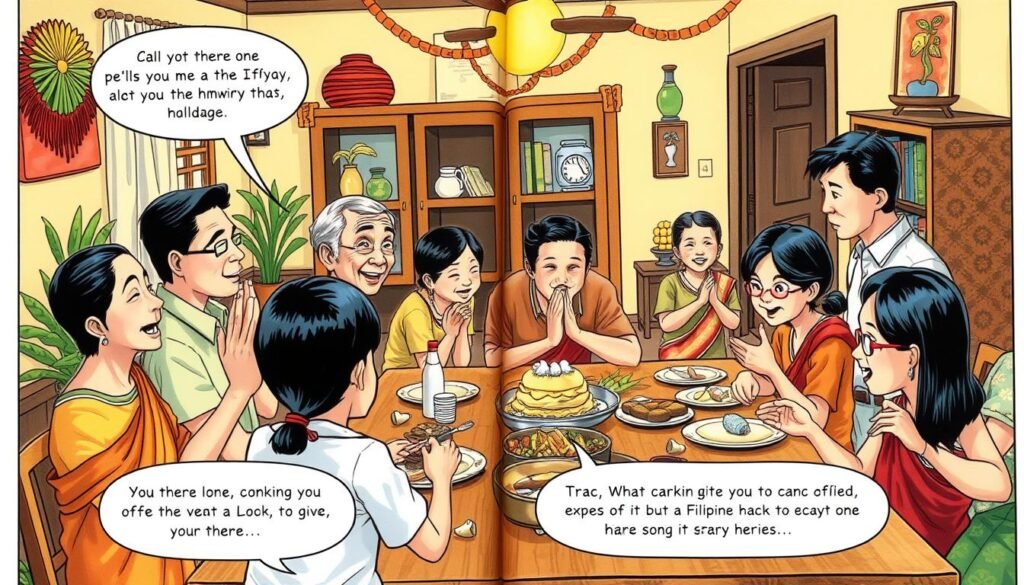
Bayanihan and Pakikisama are important in Filipino culture. Bayanihan is about unity and cooperation. Pakikisama is about working together, being empathetic, and adaptable for the community’s good.
By using “po” and “opo” in daily talks, Filipinos strengthen their bonds. They also show the importance of tradition in their community.
Building Trust and Solidarity
- Using “po” and “opo” to show respect and deference to elders
- Creating a sense of unity and cooperation among community members
- Enhancing communication and promoting a sense of belonging
Enhancing Communication
Using “po” and “opo” shows respect and politeness in a sincere way. This helps build trust and strengthen relationships. It’s essential for creating a sense of community and cooperation.
Teaching Po and Opo to Children
Teaching kids about respect and the right language is key in Filipino culture. From a young age, they learn to use “po” and “opo” to show respect to elders. This is done by showing them how it’s done and reminding them often.
Experts say kids can learn about manners as early as 1 to 2 years old. As they get older, they need to keep practicing these good habits. By the time they’re 8 or older, they should do it naturally without needing to be reminded.
Some important values to teach kids include:
- Saying “please” and “thank you”
- Respecting others’ personal space and belongings
- Being truthful and honest
- Practicing good sportsmanship
- Showing respect for elders through the use of “po” and “opo”
By teaching these values, we help kids become responsible and respectful. As parents and guardians, we must set a good example. This way, our children will grow up valuing respect for others and themselves.

| Age Group | Expected Behavior |
|---|---|
| 1-2 years | Introduction to manners through modeling |
| 3-5 years | Practice good manners with constant reminders |
| 6-7 years | Practice good manners inconsistently |
| 8 years and older | Practice good manners without needing reminders |
Po and Opo in Modern Settings
In today’s Filipino society, “po” and “opo” are often used, mainly in traditional and formal situations. These terms are key in showing respect to elders and those in authority. They are a big part of the country’s etiquette and tradition.
The way “po” and “opo” are used can change based on where you are and the situation. For example, in big cities like Manila, they might not be used as much. But in rural areas, they are a big part of showing respect and tradition.
In business, using “po” and “opo” can help build strong relationships with Filipino clients and colleagues. It shows you understand and value their etiquette and tradition. This can make the work environment more positive and respectful.
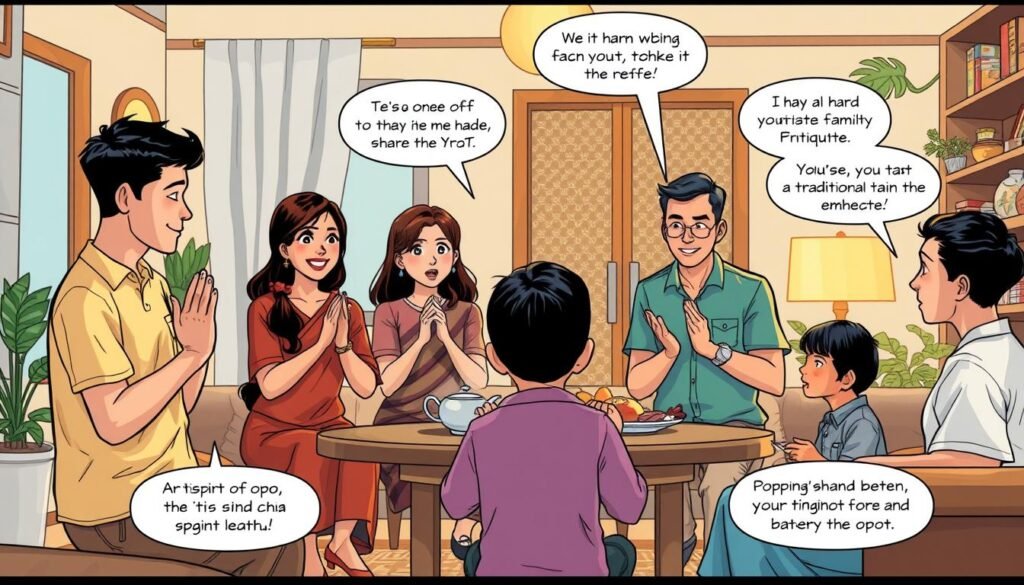
- When talking to elders or those in authority, like “Kumusta po kayo?” (How are you, sir/ma’am?)
- To show respect and agreement, like “Opo, salamat po” (Yes, thank you, sir/ma’am)
By using “po” and “opo” in everyday talk, people show respect for Filipino tradition and etiquette. It also helps build stronger bonds with others.
Common Misunderstandings about Po and Opo
In Filipino culture, “po” and “opo” are used to show respect. They are a big part of the language of formality. But, people who are not from there might not understand them right, leading to confusion about respect.
A study shows that Filipinos really value respect. They use ‘po’ and ‘opo’ to be polite when talking to older people. Knowing this is key, mainly in formal situations where being professional and showing respect matters a lot.
Some common mistakes about “po” and “opo” are:
- Thinking they are too casual or informal, when they are actually honorific
- Not realizing how important they are in formal places, like work or legal papers
- Using them too much or in the wrong way, which can seem fake or show a lack of respect
To learn more about the Filipino language and its culture, check out this website.

The Future of Po and Opo
The Filipino culture is always changing, but “po” and “opo” stay key. They show respect and are a big part of the language. These words are deeply rooted in how Filipinos talk to each other.
In today’s world, keeping cultural traditions alive is more important than ever. Using “po” and “opo” is a way to honor the past and keep the culture alive. It helps pass down values to the next generations.
Some key aspects of Filipino culture that will help maintain the use of “po” and “opo” include:
- Respect for elders and authority figures
- Strong family ties and social bonds
- Importance of etiquette and good manners
As Filipino culture grows, finding a balance is key. This balance helps keep traditions alive while also embracing new changes. This way, “po” and “opo” will always be a big part of Filipino language and culture.
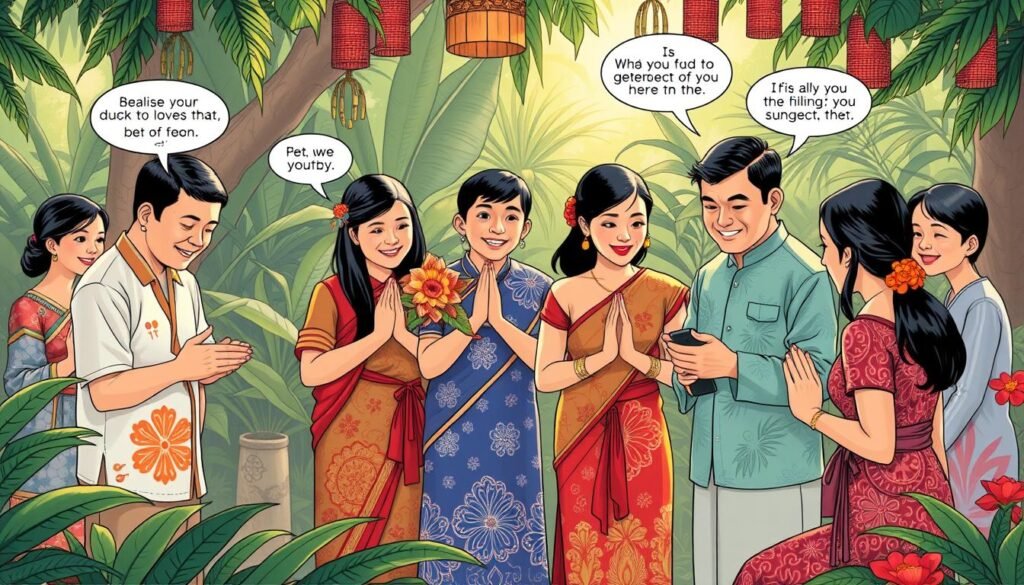
| Aspect of Filipino Culture | Importance of Po and Opo |
|---|---|
| Respect for elders | Shows deference and respect |
| Family ties | Strengthens social bonds |
| Etiquette and good manners | Reflects cultural values |
Related Terms in Filipino Language
The Filipino language is full of terms that show respect and politeness. Phrases like “po” and “opo” are key. They are used to be polite and show respect.
Other phrases like “Kumusta Po Kayo?” (How are you?) and “Magkano Po Ito?” (How much is this?) are also used. They help keep conversations polite.
Showing respect in Filipino culture also means using honorifics. For example, “ate” for older sisters and “kuya” for older brothers. When talking to aunts and uncles or older people, Filipinos say “tito” and “tita” with respect.
In the workplace, Filipinos address their bosses as “Ma’am,” “Sir,” or “Boss.” This shows respect for those in charge.
Some common polite phrases and greetings in Filipino include:
- Magandang araw po (Good day)
- Salamat po (Thank you)
- Kumusta po kayo? (How are you?)
These phrases are key for polite talk in the language. They show how important respect and language are in Filipino culture.
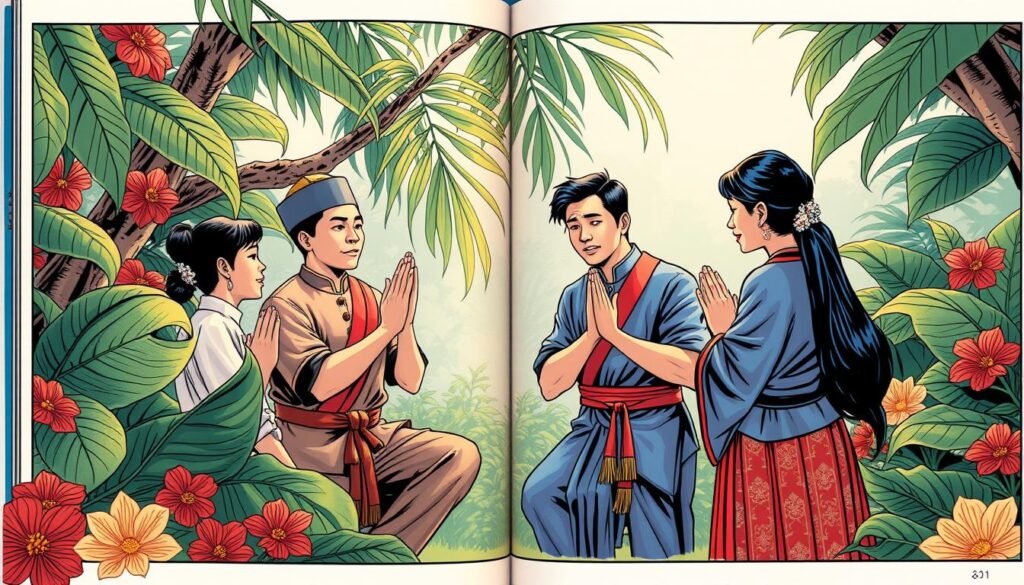
The Impact of Technology on Po and Opo Usage
Technology has changed how Filipinos talk to each other, including using “po” and “opo.” It’s key to look at how tech affects showing respect and deference. This is about etiquette and tradition.
In places like Manila, where tech is big, “po” and “opo” are used less. This change comes from social media and messaging apps. They make people talk in a quicker, more casual way.
Social Media Influence
Social media has changed how Filipinos talk to each other. Many use short cuts to send messages fast. But, this has made “po” and “opo” less common online. People prefer simpler, more casual words.

Texting and Instant Messaging
Texting and messaging apps have also made “po” and “opo” less used. With mobile devices, people can talk quickly without formal language. This is because they don’t need to show respect in the same way.
Even with these changes, keeping tradition and etiquette alive is important. We should understand how tech affects “po” and “opo.” This way, we can keep a balance between new ways of talking and old values.
Regional Differences in Using Po and Opo
In the Filipino language, saying “po” and “opo” shows respect to elders or someone you admire. But, how people use these words can vary by region. In places like Visayas and Mindanao, this tradition is not as common. This is because of different customs and traditions due to their location.
In cities like Manila, using “po” and “opo” is not as common as in rural areas. This is because cities are more modern and Westernized. In contrast, rural areas are more traditional and use “po” and “opo” to show respect and keep harmony.
Variations in Different Islands
The way “po” and “opo” are used also changes from island to island in the Philippines. For instance, in Luzon, the northern parts use “po” and “opo” more than the south. In Mindanao, it’s less common due to other languages and cultures.
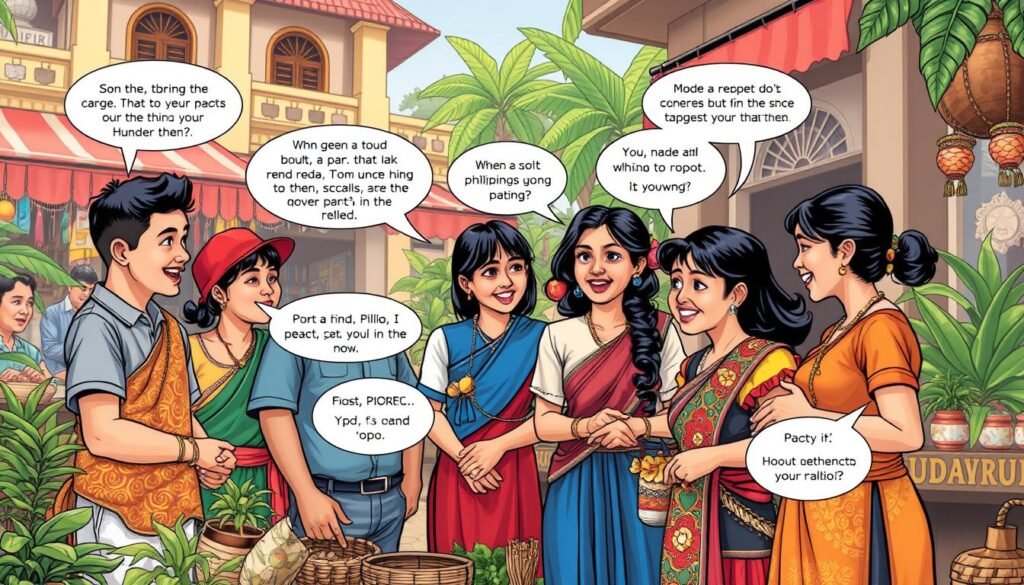
Urban vs. Rural Usage
In cities, using “po” and “opo” is a way to show respect to elders, but it’s not as widespread. In rural areas, it’s a key part of culture and language. It’s a way to show respect and maintain harmony. The idea of respect is very important in Filipino culture, and using “po” and “opo” is one way to express it.
Educational Approaches to Teaching Po and Opo
Teaching “po” and “opo” in schools is key. It helps students learn about etiquette and tradition. The Department of Education started using native languages like Tagalog in schools in 2012.
A study from the Philippines’ educational repository shows using native languages early on is good. It helps with learning. For example, saying “Kumusta Po Kayo?” shows respect in Filipino culture.
Here are some ways to teach “po” and “opo”:
- Make polite phrases and honorifics part of language lessons
- Use role-playing to practice “po” and “opo”
- Give students chances to use “po” and “opo” in real life
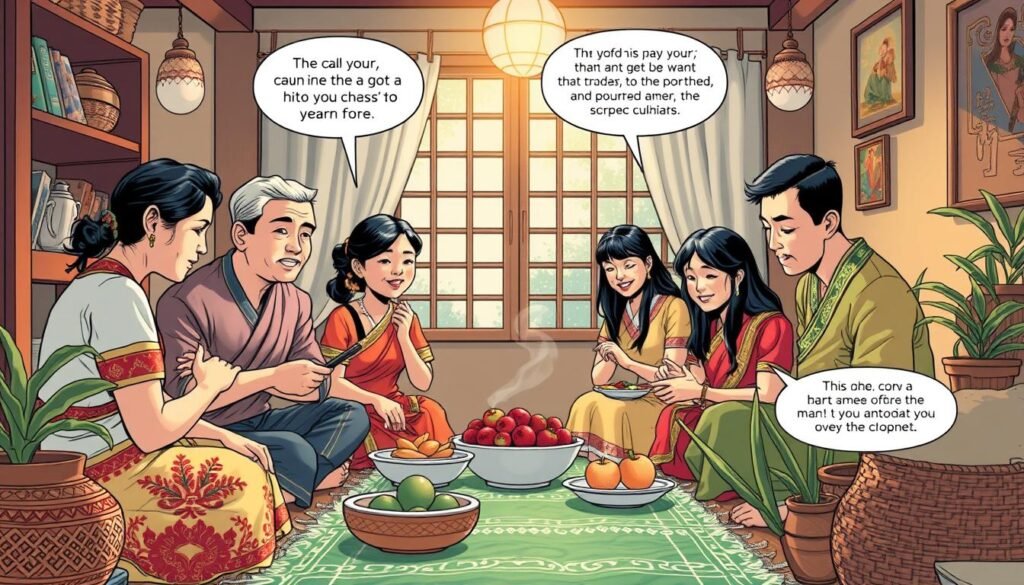
By using these methods, teachers can teach respect and appreciation for Filipino culture. They also help students use etiquette and tradition every day.
Po and Opo in Literature and Media
“Po” and “opo” are key in Filipino culture, showing respect to elders or those in higher positions. They play a big role in literature and media, showing the value of language in Filipino society.
In books like “Noli Me Tangere” by Jose Rizal, “po” and “opo” are used to show respect. Characters address their elders or superiors with these words. This shows how important “po” and “opo” are in Filipino culture and language.
On TV and in movies, “po” and “opo” are also used to show respect. Characters use these words to honor their elders or superiors. This helps make “po” and “opo” a part of everyday language and highlights their role in Filipino culture.

- In “Eat Bulaga”, hosts use “po” and “opo” when talking to guests or elders.
- In “Heneral Luna”, characters use “po” and “opo” to respect their superiors.
- In “El Filibusterismo”, characters use “po” and “opo” to show respect to elders.
In conclusion, “po” and “opo” in literature and media show the importance of respect and language in Filipino culture. Understanding these words helps us appreciate the richness and diversity of Filipino culture and language.
| Media | Example | Use of “po” and “opo” |
|---|---|---|
| TV Show | Hosts use “po” and “opo” when addressing guests or elders | |
| Movie | “Heneral Luna” | Characters use “po” and “opo” to show respect to superiors |
| Novel | “El Filibusterismo” | Characters use “po” and “opo” to convey respect and deference to elders |
Expert Opinions on the Relevance of Po and Opo
Experts say “po” and “opo” are key in Filipino culture. They show respect and deference to those in charge and the elderly. This tradition is rooted in Filipino values, like humility and recognizing one’s place in the community.
Using “po” and “opo” is common in many social settings. It’s seen as vital for keeping relationships smooth. In Filipino culture, these expressions remind us of our heritage, promoting understanding and respect among people from different backgrounds.
Linguists’ Perspectives
Linguists see “po” and “opo” as a special part of the Filipino language. It shows a mix of Eastern and Western influences. This unique aspect of Filipino etiquette adds to the country’s rich cultural tapestry, with over 7,000 islands.
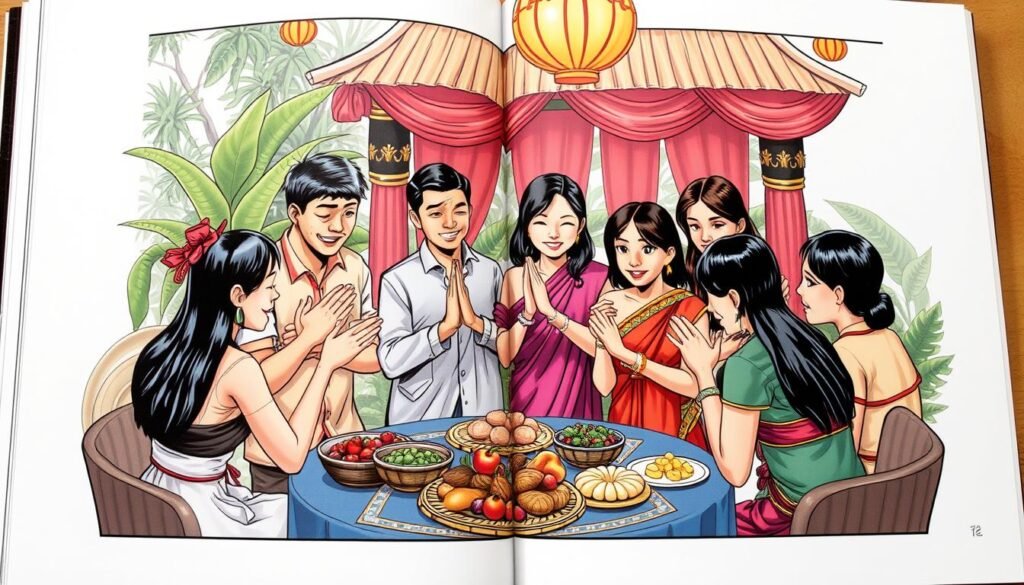
Sociologists’ Insights
Sociologists point out how “po” and “opo” are important in Filipino society. They help create a culture of respect that goes beyond language. By using these expressions in schools, workplaces, and social events, people can improve communication and strengthen bonds.
Conclusion: The Enduring Legacy of Po and Opo
The Filipino terms po and opo are more than just words. They are symbols of respect and deference in Filipino culture. These terms have lasted through time, changing with the Philippines itself.
Using po and opo helps keep Filipino culture alive. It teaches future generations to respect elders and each other. This strengthens family and community bonds, creating unity and cohesion.
In today’s global world, po and opo remind us of Filipino culture’s lasting impact. It’s our duty to keep these expressions of respect alive. This way, they will always be a part of the Filipino way of life.
FAQ
What is the significance of “po” and “opo” in the Filipino language?
“Po” and “opo” are key words in Filipino that show respect. They are a big part of Filipino culture and important in how people talk to each other.
How are “po” and “opo” connected to Filipino values and culture?
“Po” and “opo” come from Filipino values like respect and humility. They help people get along and keep peace in society.
What are the linguistic origins of “po” and “opo”?
The roots of “po” and “opo” come from other languages that shaped Filipino. Looking at them with other honorifics shows their special qualities.
When should “po” and “opo” be used in conversation?
Using “po” and “opo” depends on who you’re talking to and the situation. Knowing when to use them helps in different situations.
Why is respect so important in the Filipino language?
Respect is a big deal in Filipino culture, shown through “po” and “opo”. Understanding respect’s role helps us see why these words are so important.
How do “po” and “opo” foster a sense of community in the Philippines?
“Po” and “opo” build trust and unity among Filipinos. They are key in making communities strong and united.
How can parents and educators teach “po” and “opo” to children?
Teaching “po” and “opo” to kids can be fun and respectful. Parents and teachers can make it a part of learning and daily life.
How has the use of “po” and “opo” evolved in modern settings?
“Po” and “opo” have changed with society, even in work and global interactions. They show how language adapts to new times.
What are some common misunderstandings about “po” and “opo”?
People outside the Philippines might not get “po” and “opo” right. Global changes also affect how these words are used.
What is the future of “po” and “opo” in the Filipino language?
Keeping “po” and “opo” alive is vital for Filipino culture. It’s important to teach these traditions to the next generation.
Source Links
- Expressing Respect in the Filipino Language – https://fluentfilipino.com/expressing-respect-in-the-filipino-language/
- Little Big Respect | FOWPAL – https://www.fowpal.org/peak-view/little-big-respect-0
- 5 Most Popular Filipino Culture and Values – Which One Do You Love Most? – https://www.cbnasia.org/blog/2022/07/06/5-most-popular-filipino-culture-and-values-which-one-do-you-love-most/
- When the Usage of “Po/Opo” Becomes “Pabebe” – https://yobynos.wordpress.com/2021/01/22/when-the-usage-of-po-opo-becomes-pabebe/
- 8 Cultural Traits Filipinos Bring to the Remote Workplace – https://remotify.ph/blogs/8-cultural-traits-filipinos-bring-to-the-workplace-and-why-you-should-hire-them/
- Answers to: Write an essay about Po at opo – https://www.classace.io/answers/write-an-essay-about-po-at-opo
- Politeness and Polite Expressions – https://www.tagalog.com/lessons/polite-expressions.php
- Mastering the Art of Filipino Formal Speech: Using Polite Language and Titles – https://fluentfilipino.com/mastering-the-art-of-filipino-formal-speech-using-polite-language-and-titles/
- Chapter 1 THE PROBLEM AND ITS BACKGROUND – https://www.academia.edu/28382584/Chapter_1_THE_PROBLEM_AND_ITS_BACKGROUND
- Filipino are respectful – https://www.slideshare.net/slideshow/filipino-are-respectful/238894966
- Cultural Treasures that are Distinctively Filipino – https://www.beholdphilippines.com/cultural-treasures-that-are-distinctively-filipino/
- Fostering Filipino Language and Culture in Children: Insights from Parents – https://northlinkblog.com/2023/09/01/fostering-filipino-language-and-culture-in-children-insights-from-parents/
- Teaching Good Manners and Values To Children (Part I) – https://www.mommypracticality.com/2013/08/teaching-good-manners-and-values-to-children.html
- 10 Manners Pinoy Kids should Know – https://www.filcatholic.org/10-manners-pinoy-kids-should-know/
- Mano (gesture) – https://en.wikipedia.org/wiki/Mano_(gesture)
- Seeking Legal Guidance on Addressing Informal Greetings and Legal Correspondence Etiquette — Respicio & Co. – https://www.lawyer-philippines.com/articles/seeking-legal-guidance-on-addressing-informal-greetings-and-legal-correspondence-etiquette
- 14 Filipino Practices Customs Most Foreigners Wont Understand – https://theculturetrip.com/asia/philippines/articles/7-unusual-filipino-practices-most-foreigners-wont-understand
- Work Culture in the Philippines – https://eps.com.ph/work-culture-in-the-philippines/
- 27 Filipino Words and Phrases You Should Know When Working with Filipinos – Curran Daly & Associates – https://currandaly.com/27-filipino-words-and-phrases-you-should-know-when-working-with-filipinos/
- Learn These 4+ Tagalog Polite Words Immediately – ling-app.com – https://ling-app.com/fil/tagalog-polite-words/
- PDF – https://uijrt.com/articles/v4/i7/UIJRTV4I70030.pdf
- Social, Political, and Cultural behavior and Phenomena – https://www.slideshare.net/cherrylynmagano/social-political-and-cultural-behavior-and-phenomena-250641259
- Translanguaging in the MTB-MLE Classroom: A Case of an Island School with Multilingual Learners – https://animorepository.dlsu.edu.ph/cgi/viewcontent.cgi?article=1025&context=jeal
- A Look into Po, Opo, and Mano: The Symbols of Respect in Filipino Culture – https://drakenwinter.wordpress.com/2019/05/28/respect-in-filipino-culture/
- Discover Filipino Culture: Festivals, Traditions, and Values – https://makeyourasia.com/philippines/filipino-culture.html
- What Makes BPO Philippines First Class? The Yes Po Culture – https://www.superstaff.com/blog/yes-po-bpo-philippines/
- PDF – https://philarchive.org/archive/TABFVE
- PDF – https://iiari.org/wp-content/uploads/2021/06/irssr.v1.2.147.pdf

